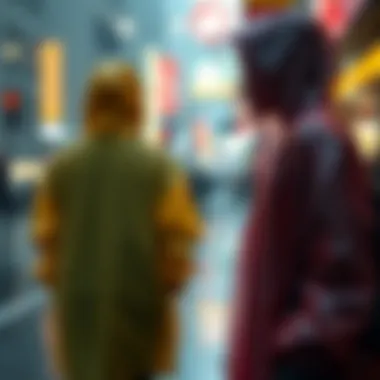Exploring the Practicality and Impact of Disposable Raincoats


Intro
Disposable raincoats have become the unsung heroes of unpredictable weather, popping up at music festivals, outdoor events, and travel adventures with increasing frequency. Their lightweight design and affordable price have made them a stylish emergency solution for those caught in sudden downpours. But how much do we really understand about these handy garments? This article dives into the nitty-gritty of disposable raincoats, exploring their materials, practical uses, and their standing in the context of sustainability. By tracing their evolution and relevance in today's fashion landscape, readers will grasp the full impact of choosing a disposable raincoat over more traditional options.
Fabric Knowledge
Understanding the fabrics used in disposable raincoats can greatly impact your choice when selecting one for your next outing. While they may appear benign at first glance, these garments are often crafted from various materials that each have their own characteristics.
Types of Fabrics
The key fabrics you might encounter include:
- Polyethylene: This widely used plastic creates inexpensive raincoats that are waterproof and lightweight. However, they are often not breathable, leading to wearers feeling clammy.
- Polyvinyl Chloride (PVC): Durable and slightly more rigid than polyethylene, PVC raincoats offer a good barrier against water, but they have their drawbacks, such as being less eco-friendly.
- Non-Woven Fabrics: Often made from recycled materials, non-woven raincoats can balance comfort with functionality, though they are often less effective in heavy rain.
- Biodegradable options: A growing niche in the market involves raincoats made from materials designed to break down over time, catering to environmentally conscious consumers.
How to Care for Different Fabrics
Proper care is crucial to extend the lifespan of disposable raincoats. While many consumers may view them as single-use items, here are a few tips for maintaining them, particularly for those designed for limited reuse:
- Polyethylene: Store in a cool, dry place. Wipe clean with a damp cloth if they get dirty—but avoid submerging in water.
- PVC: Clean with a gentle detergent. Roll them up carefully to avoid crumpling, and always avoid direct sunlight for prolonged periods to prevent fading.
- Non-Woven Fabrics: The most forgiving of the types, they can usually withstand a gentle wash. Just be sure to follow the manufacturer's care instructions.
- Biodegradable options: Store as you would cotton or other biodegradable materials, ensuring they do not get wet before disposal.
"Understanding the materials behind disposable raincoats can empower consumers to make more informed choices, aligning fashion with conscious living."
Practical Applications
Disposable raincoats shine in a variety of practical settings. They're ideal not just for unexpected rain showers but also for festivals, parades, and sporting events. Travelers often appreciate their convenience when light packing is necessary. Additionally, businesses leveraging disposable raincoats during events can showcase their commitment to sustainability by opting for eco-friendly fabrics.
While consumers might lean towards the easy option, it’s essential to consider the environmental implications of their choices. This leads to a thoughtful comparison between disposable and reusable raincoats, where factors like frequency of use, disposal methods, and overall ecological impact come into play.
Culmination
In an era where environmental responsibility is more pressing than ever, understanding the ins and outs of disposable raincoats provides clarity. Their practicality is evident, but the implications of their materials push us to think deeply about our choices in the context of sustainability. As we navigate through unpredictable weather and our clothing choices, disposable raincoats stand at a crossroads of fashion and functionality, challenging consumers to weigh convenience against conscience.
For anyone interested in exploring sustainable clothing options further, sites like Wikipedia, Britannica, and community discussions on Reddit can prove invaluable.
Prolusion to Disposable Raincoats
In today's fast-paced world, the utility of disposable raincoats has surged, especially for those who appreciate convenience alongside functionality. While traditionally viewed as merely practical, these garments represent much more—offering protection against unpredictable weather while catering to varied lifestyles. For fashion enthusiasts and retailers, understanding disposable raincoats can unveil opportunities for innovation in product offerings.
Definition and Overview
Disposable raincoats are lightweight, waterproof outer garments designed for single-use, meant to shield the wearer from rain and moisture. Typically produced from inexpensive materials like polyethylene or nylon, these raincoats are precut and folded in compact packages, making them easy to store and deploy. The appeal lies in their ability to be rapidly donned, without the concern for care or maintenance typically associated with regular rain gear.
The primary audience for these coats ranges from outdoor festival-goers to travelers who wish to avoid getting drenched during surprise rain showers. Their cost-effectiveness adds to their allure, making them an accessible choice for large groups or events where individual attire may not be as easily justified.
Historical Background
The evolution of disposable raincoats can be traced back to the mid-20th century when rapid industrial advancements allowed for more efficient production methods. Initially marketed for emergency use, military applications, and various outdoor activities, their existence paved the way for further exploration into disposable clothing.
As time went on, disposable raincoats began to crop up in everyday life. They made their grand entrance at public events, providing an easy solution for people caught unprepared by the elements. The late 1980s and early 1990s marked a turning point, as designs became more specialized, featuring elements like hoods and varied sizing to accommodate diverse demographics. By the turn of the millennium, the concept of a quick, hassle-free rain barrier became common in many urban centers, further embedding disposable raincoats into the fabric of modern consumer culture.
"The efficiency and convenience offered by disposable raincoats provide modern solutions to age-old weather woes, enriching experiences across cultural events and leisure activities."
As concerns about sustainability and fashion ethics grow, understanding the origins and impacts of disposable raincoats becomes essential for anyone engaged in the fashion industry. This exploration leads us to delve deeper into the materials and processes involved in creating a raincoat that meets today's standards of both utility and style.
Materials and Design
The significance of materials and design cannot be overstated when it comes to disposable raincoats. They are not just pieces of fabric thrown together but rather a crucial factor that affects performance, comfort, and usability. Choosing the right material directly impacts the coat’s waterproofing ability, weight, durability, and even its environmental impact. Design elements play a vital role in ensuring a good fit and effective coverage. Thus, diving into these topics offers insight into how disposable raincoats can meet diverse needs effectively.
Common Materials Used
Polyethylene
Polyethylene is one of the most common materials utilized in disposable raincoats. It is often chosen for its lightweight properties, which make it easy to carry around, especially in unexpected rainy situations. The unique aspect of polyethylene lies in its resistance to moisture, meaning it can effectively keep the wearer dry without adding unnecessary bulk. This material is generally very affordable, making it accessible for a wide audience.
However, while polyethylene is celebrated for its practicality, there are drawbacks. One notable disadvantage is its limited durability; it can be prone to tearing under stress which might be a concern for more active users. Still, for short-term use, it frequently proves to be a popular choice.


Nylon
Nylon is another fabric gaining traction in the realm of disposable raincoats. Known for its impressive strength and resilience, it's often used for its ability to withstand wear and tear better than polyethylene. The key characteristic of nylon is its capacity for better breathability, which often translates to increased comfort during wear.
This material is also less susceptible to tearing, which is a major advantage when navigating windy or challenging conditions. However, it's important to note that nylon can be heavier, which makes it less convenient for carrying around than polyethylene. It does come at a higher cost, but the balance of durability and comfort can make it a worthwhile investment for many.
Vinyl
Vinyl, another contender, offers a different set of features that can be very beneficial for specific scenarios. The unique feature of vinyl is its impressive waterproofness, making it a reliable option for heavy downpours. It provides a solid barrier against water, keeping the wearer dry while remaining relatively lightweight. Moreover, its smooth surface allows for easy cleaning, enhancing its reusability in some cases.
However, one downside of vinyl is its stiffness, which may not provide the same range of motion as other materials. Additionally, it can trap heat, potentially making it uncomfortable over extended periods. That said, for quick, effective protection from the rain, vinyl remains a valuable choice.
Design Features
Hoods
When it comes to design elements, hoods are one of the most significant features of disposable raincoats. They serve a practical purpose by providing added protection to the head and neck, areas often exposed to the elements. The key selling point of a hood is its functionality; it allows for better coverage without the need for additional headgear, which can be cumbersome.
Many hoods are designed to be adjustable, enabling users to secure them better against wind and rain. This added versatility makes them a preferred feature. On the flip side, hoods can sometimes restrict visibility or feel bulky, which may not work for everyone. Therefore, style preferences and comfort must be considered when evaluating this feature.
Seam Sealing
Seam sealing is another vital element in the design of disposable raincoats. It ensures that all seams are properly sealed to prevent water from leaking through, significantly increasing the coat’s overall effectiveness. This feature is essential for those who require reliable waterproofing in heavy rainfall or harsh conditions. A well-sealed seam can be likened to insurance; it provides peace of mind when you are caught in a storm.
However, not all disposable raincoats prioritize seam sealing. Those that do tend to be slightly bulkier, which could affect portability. Balancing the benefits of seam sealing with its implications for weight and design is crucial for manufacturers aiming to cater to varying consumer needs.
Sizes and Fits
Finally, sizes and fits can largely dictate the functionality and comfort of disposable raincoats. The availability of different sizes helps ensure that a wider audience can find a fitting option. A well-fitted raincoat offers better protection against rain, as excess fabric can lead to gaps where water can enter, while a snug fit can limit mobility. This is where careful consideration comes into play; selecting a raincoat that accommodates different body types without compromising functionality is a challenge designers face.
Moreover, having options for various fits, such as tailored or oversized designs, allows users to choose based on personal preference and activity level. However, the added variety can complicate inventory management for retailers. Striking a balance is vital to avoid overwhelming potential buyers with too many choices.
In sum, the consideration of materials and design aspects is crucial for understanding the role of disposable raincoats in practical applications and consumer preferences in today’s market.
Practical Applications
The practical applications of disposable raincoats can’t be overlooked. Their significance spans various fields and activities, making them not only functional but also a necessity for many. As rain or unexpected weather can throw a wrench in any outdoor plan, these raincoats fill a gap that many might not have considered, offering quick solutions that don’t cost an arm and a leg.
Usage During Events
Outdoor Festivals
Outdoor festivals attract crowds from all walks of life. The music, food, and community vibe are what draw people together. However, the unpredictable weather can dampen the spirit, and this is where disposable raincoats become essential. They are a practical choice for such events since they are easily portable and can be quickly donned when the rain starts to pour.
A unique feature of outdoor festivals is the relaxed atmosphere. Folks won’t mind wearing something that might not be designer or high-end as long as it keeps them dry. This leaves attendees free to enjoy the festivities without worrying about ruining their outfits. The cost-effectiveness of these raincoats also appeals to festival-goers who may be reluctant to part with substantial money for something they’ll use for a few hours.
Sporting Events
Rain can be a game changer at sporting events. Whether it’s football, soccer, or any other outdoor sport, players and spectators alike need protection from the elements. Disposable raincoats are particularly advantageous here because of their ease of use. Spectators attending a game don’t want to miss out on the action, and with these raincoats, they can stay dry without sacrificing comfort.
The key aspect of sporting events is professionalism and teamwork where every participant aims for a great experience. The light and functional nature of the raincoat allows everyone to enjoy the event to the fullest. A downside might be that these coats are not as robust, but for a short-term fix? They more than fit the bill.
Concerts
Concerts can draw thousands of fans, and it’s critical to keep the vibe lively despite the weather. Here, disposable raincoats serve to maintain the enjoyment of the evening. Concert-goers can continue singing along to their favorite tunes and dancing to the rhythm without getting drenched.
The visual spectacle that concerts provide is often enhanced by the community. Seeing a sea of colorful raincoats amidst a downpour can actually be quite uplifting. However, a notable downside is that they may lack style, which is sometimes important in these settings.
Travel Convenience
Compact Storage
Packability is crucial for travelers, and this is where the compact storage of disposable raincoats shines. As they can be folded down to nearly nothing, they fit snugly in backpacks or handbags, ensuring minimal bulk during travels. This feature means wanderers can easily carry them while exploring new territories without feeling weighed down.
The emphasis on lightweight travel in today’s world makes these raincoats a popular choice for those looking to streamline their packing. Nevertheless, they might not be durable enough for frequent use, which is something travelers should consider.


Lightweight Option
A lightweight option is a godsend for any traveler. Heavy gear can quickly become burdensome, especially while navigating through busy airports or train stations. Disposable raincoats are featherlight and easy to put on or take off as needed. They provide a quick solution to sudden rainstorms without compromising on mobility.
Ultimately, having the ability to stay dry without carrying a cumbersome jacket is a game changer, especially when it’s not a certainty that rain will come. Of course, for longer trips, a more durable coat may be necessary.
Emergency Situations
In emergency situations, preparedness is key. Disposable raincoats come in handy when inclement weather hits unexpectedly. For instance, during a disaster preparedness drill or an outdoor activity that turns stormy, having these rain jackets on hand can be crucial.
Their readiness for quick deployment means that they can provide immediate protection when time is of the essence. The downside might come from the fact that they aren't designed for long-term use if the situation drags on, but as a temporary fix? They save the day.
Workplace Applications
Construction Sites
Construction sites often face the elements straight up. Rain can cause work stoppages and safety hazards, making the role of disposable raincoats vital. These jackets offer on-the-spot protection for workers who may need to rush outdoors to address urgent issues. A notable characteristic is the ability to keep workers dry while they maintain productivity.
This is a beneficial approach as it minimizes downtime during drizzle, ensuring that projects remain on schedule. Nevertheless, one must be aware that while they provide short-term protection, long-lasting weather gear is more advisable for everyday use.
Field Work
Field workers often find themselves at the mercy of the weather. Having a supply of disposable raincoats allows them to stay focused on their tasks without the discomfort of being wet or cold. This is particularly important in various scientific or environmental studies where conditions can change rapidly.
The expediency of being able to quickly grab a raincoat ensures that workflows are minimally disrupted by adverse weather conditions. There may be concerns regarding sustainability and quality, but in many scenarios, the advantages far outweigh the downsides.
Outdoor Tours
Outdoor tours can sometimes be unpredictable. Whether it’s a nature hike, a city walking tour, or a wildlife expedition, a sudden downpour can catch anyone off guard. With disposable raincoats, tour guides can ensure that all participants stay comfortable even when surprise weather occurs. Their ease of use is paramount during spontaneous events.
Because tourists might not want to lug around heavy rain gear, these coats provide a convenient alternative that can be easily tossed after use. However, the lack of style can occasionally come into play, as some might want to look fashionable while being in nature.
The beauty of disposable raincoats lies in their versatility across various applications, making them an essential component for both leisure and practical scenarios.
Comparative Analysis with Reusable Alternatives
The discussion surrounding disposable raincoats inevitably leads to a comparative analysis with their reusable counterparts. Understanding this comparison is crucial as it highlights the benefits and considerations that influence consumer choices. In a world where sustainability is becoming more prevalent, the dynamics between disposable and reusable raincoats provide insights into how these garments align with modern values around convenience, cost, and environmental responsibility.
Advantages of Disposable Raincoats
Cost-Effectiveness
Cost-effectiveness stands out as one of the primary benefits of disposable raincoats. These garments are typically priced lower than their reusable allies, making them a practical choice for many individuals. The economical aspect caters well to large gatherings, outdoor events, or festivals, where a group might need protection from unexpected downpours. The unique feature of this cost-effective option is that it allows consumers to shield themselves from the elements without a significant investment. However, while the price point is tempting, it also leads to discussions about how frequently one disposes of these items compared to investing in a higher-quality, long-lasting raincoat.
Minimal Maintenance
Another advantage is the minimal maintenance required for disposable raincoats. Unlike reusable jackets, which need regular washing and care, disposable raincoats come ready for action straight out of the packaging. Once they’ve done their job, they can be discarded without the need for any post-use cleaning or storage considerations. This ease of use is particularly appealing for people on the go or in unpredictable weather, eliminating worries about stains or odor. However, the downside here is that this convenience does not promote a culture of garment care, potentially encouraging a throwaway mindset that could become detrimental in the long run.
One-Time Use Convenience
One-time use convenience encapsulates the core appeal of disposable raincoats. In situations where you may not want to carry a bulky raincoat or where space is at a premium—like during concerts, festivals, or while traveling—these lightweight options come into play. The ability to pack a raincoat that you can toss after wearing is undeniably appealing, especially when you're faced with the unexpected. However, while one-time use may solve immediate problems, it can also cough up conversations around how many of these single-use items it takes to cross the line into wastefulness.
Limitations and Considerations
Environmental Impact
The environmental impact associated with disposable raincoats is a serious consideration. Each coat, while serving its purpose during a storm, contributes to landfill issues if not disposed of properly. This characteristic weighs heavily against their convenience, raising questions about the sustainability of such products. While they offer immediate protection, the long-term effects on ecosystems must not be overlooked. Recognizing this aspect is vital as consumers grapple with choices that align with environmental consciousness.
Durability Issues
Despite their cost-effective nature, disposable raincoats often face criticism regarding durability. These garments are designed for light use, and consumers might find them easily ripped or torn in harsher weather conditions. The use of thinner materials can lead to leaks and tears, effectively nullifying their purpose in heavy rain. While they may work well for a light drizzle, durability is a significant factor that discourages some consumers from relying on them as their go-to option for inclement weather.
Fashion Perception
Finally, the prevailing fashion perception surrounding disposable raincoats is yet another consideration. They are often viewed as a less stylish alternative to more fashionable reusable rain jackets. As sustainability and style become increasingly interwoven in consumer decisions, the fashion industry is slowly evolving to accommodate more eco-friendly options without sacrificing aesthetics. Disposable raincoats may not always meet the style benchmarks set by their reusable counterparts, which sparks debates about their role in the larger clothing market. This perception can affect consumer behavior, potentially positioning disposable raincoats on the fringe of fashion choices.


"A raincoat should not only serve to keep you dry but also reflect your sense of style."
In summary, while disposable raincoats present undeniable advantages, the challenges they pose—especially regarding environmental concerns and durability—cannot be ignored in this comparative analysis with reusable alternatives. Understanding these dynamics enables consumers to make more informed decisions, fostering a balance between immediate needs and longer-term responsibility.
Sustainability Concerns
The subject of sustainability cannot be overstated in today's context, especially when discussing disposable raincoats. The fashion world, traditionally viewed as polluting, is increasingly pivoting towards sustainability. Disposable raincoats, while practical in many ways, have their own environmental implications. Examining this aspect sheds light on both their benefits and challenges, which ultimately aids consumers in making more informed choices.
Environmental Footprint
When considering the environmental footprint of disposable raincoats, it is essential to understand their journey from production to disposal. Most of these raincoats are made from materials like polyethylene and vinyl, which often lack biodegradability. Their production processes can consume considerable fossil fuels and water, contributing to greenhouse gas emissions.
- Production Impact: The manufacturing of plastic-based raincoats involves extracting petroleum, which is not only energy-intensive but also harmful to ecosystems.
- Post-Consumer Waste: Once disposed of, these jackets typically end up in landfills where they can take hundreds of years to decompose. Unlike seasonal wear, they present a more significant waste challenge.
Despite these concerns, there are movements leveraging technology to reduce this footprint, including exploring more sustainable materials and improving manufacturing processes.
Biodegradable Options
As the demand for more sustainable fashion rises, biodegradable disposable raincoats are emerging on the scene. These products aim to blend convenience with ecological responsibility. Unlike conventional plastic raincoats, biodegradable options are formulated to break down more swiftly in the right environments.
- Materials Used: Composed of organic compounds, these raincoats can decompose into non-toxic substances. Some brands use plant-based materials that are both lightweight and functional.
- Market Response: Companies are increasingly investing in R&D to produce viable biodegradable raincoat options. This allows consumers to make choices that align with their values, addressing the negative environmental impacts often associated with traditional plastics.
"The future of disposable raincoats lies in innovation, where functionality meets eco-friendliness."
Recycling Initiatives
Recycling represents a pivotal part of tackling the sustainability issue head-on, even with disposable items like raincoats. While most of these jackets are not commonly accepted in curbside recycling bins, initiatives are emerging to facilitate better waste management practices.
- Collective Responsibility: Organizations and communities can lead the charge by establishing collection points specifically for plastic raincoats, where they can be processed correctly.
- Awareness Programs: Campaigns aimed at educating consumers about proper disposal methods and recycling possibilities play a crucial role. They spark a change in mindsets, urging people to think twice before tossing their raincoat into the trash.
- Brand Take-back Schemes: Some companies are setting up their own recycling schemes, offering customers incentives to send back their used raincoats for responsible recycling or repurposing.
The ongoing dialogue around sustainability is not merely an external obligation but a shared responsibility among consumers, brands, and producers alike. By understanding and addressing these sustainability concerns regarding disposable raincoats, the industry can take steps toward more responsible consumption. The journey towards sustainability in fashion is gradual but imperative, calling for thoughtful engagement from every stakeholder.
Future Trends in Disposable Raincoat Design
The future of disposable raincoats stands at a fascinating crossroads. As environmental consciousness rises and technological advancements escalate, changes are poised to emerge in both design and consumer behavior. Understanding these trends is not just important for manufacturers, but also for consumers, retailers, and anyone with a stake in the fashion industry.
Technological Innovations
Recently, there’s been a significant shift towards integrating cutting-edge technology in the design of disposable raincoats. These innovations aim not just to enhance performance but also to mitigate environmental concerns. For instance, the introduction of smart fabrics can make these raincoats not only waterproof but also breathable. By employing advanced polymer technologies, manufacturers can create lightweight materials that keep moisture out while allowing body heat to escape. This dual-functionality addresses comfort, making disposable raincoats far more appealing for extended wear.
Furthermore, businesses are exploring advanced production methodologies. Techniques like 3D printing open the door to efficient manufacturing processes that reduce waste. Instead of traditional mass production, items can be made on-demand. This minimizes overproduction and waste, aligning with a more sustainable approach.
"The dawn of smart materials in disposable clothing can reshape consumer perceptions towards practicality and sustainability."
There’s also potential for recycling innovations. Companies are now experimenting with raincoat designs that can be returned after use, allowing for recycling or upcycling into new products. This not only addresses waste concerns but also fosters a circular economy, reducing the overall environmental footprint.
Consumer Preferences Shifting
As the conversation around sustainability evolves, so too do consumer preferences. Today’s eco-conscious shoppers are not just looking for functionality; they expect sophistication and environmental responsibility from the disposable products they choose.
A trend that’s becoming increasingly apparent is the move towards stylish designs. Previously, disposable raincoats were viewed as a last resort, often compromising on aesthetics. However, with rising competition, brands are beginning to offer options with fashionable cuts and colors that can appeal to a broader audience. This focus on style helps break stigmas surrounding disposable rainwear. Consumers no longer need to choose between practicality and appearance.
Moreover, transparency in sourcing materials is becoming a significant factor. Consumers want to know how and where a product is made. This demand encourages companies to provide detailed information about their materials and manufacturing processes. Brands that embrace this transparency tend to build trust with their consumers, influencing purchasing decisions.
There’s also a notable increase in niche marketing for specific situations; for example, travel enthusiasts are drawn to raincoats that fold into a compact pouch, ideal for stowing away in a backpack. Event-goers may prefer unique designs that allow them to stand out while staying dry. Understanding these shifting preferences allows companies to tailor their offerings better.
Epilogue
In wrapping up our exploration of disposable raincoats, it becomes evident that these garments play a significant role in today’s fast-paced living. Their functionality is not merely a matter of avoiding a downpour; it reflects deeper consumer behavior and shifts in lifestyle needs. Disposable raincoats provide a practical solution for an array of scenarios ranging from festivals to unpredictable travel weather. As we've seen, the ease of use, combined with cost-effectiveness, often appeals to individuals who prioritize convenience over longevity.
Summary of Key Points
- User Convenience: Disposable raincoats are lightweight and easy to carry, making them ideal for emergency situations.
- Materials and Design: Typically made from materials like polyethylene, nylon, or vinyl, these raincoats can be produced quickly and affordably, appealing to a wide audience.
- Environmental Impact: While concerns exist regarding their disposability, emerging biodegradable options and recycling initiatives aim to mitigate pollution issues.
- Versatility: Their application spans various contexts, including outdoor events and travel, highlighting their importance in contemporary fashion dialogue.
Final Thoughts on Disposable Raincoats
As we step into a future where sustainability becomes stronger in the fabric of consumer demand, disposable raincoats will likely evolve too. The market may see innovations that balance convenience with environmental responsibility.
In the grand scheme, while disposable raincoats might have certain drawbacks, their benefits cannot be overlooked. They serve a special purpose, resonating with an audience that favors practicality. In an era where every decision about clothing impacts the environment, consumers are increasingly considering not just their immediate needs but the longer-term effects of their choices. Understanding this relationship and how disposable items fit within it offers valuable insights for fashion enthusiasts and retailers alike.
"Adapting to changing weather demands a flexible approach, and disposable raincoats meet this need head-on."
Thus, while some may dismiss them as mere convenience items, disposable raincoats stand as a reflection of how fashion and function intertwine in our daily lives.















